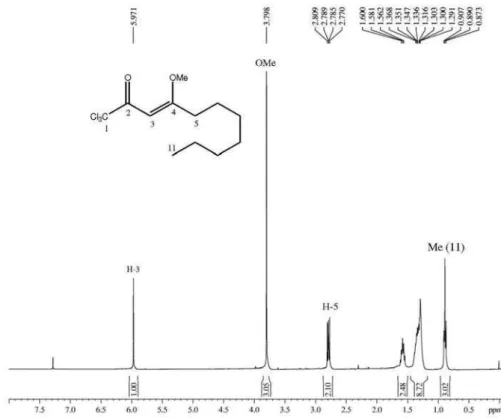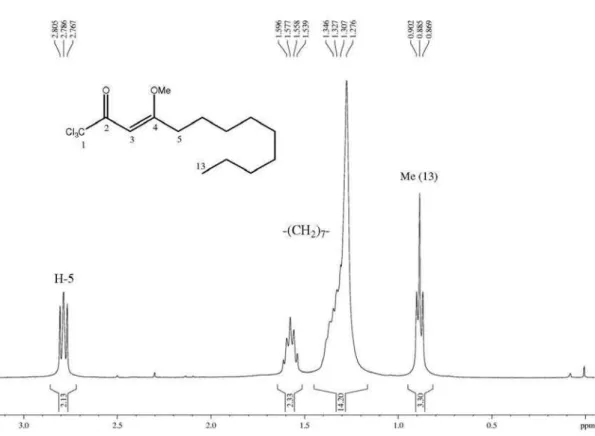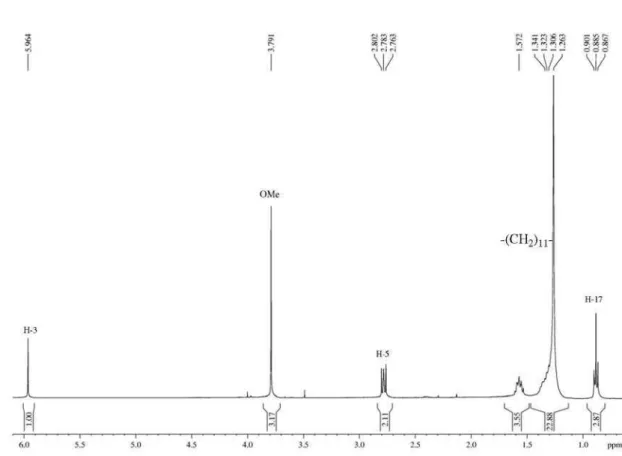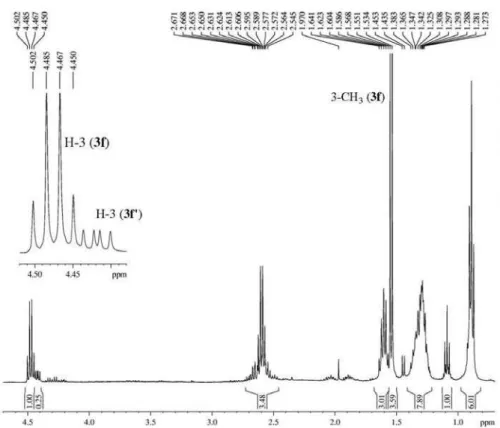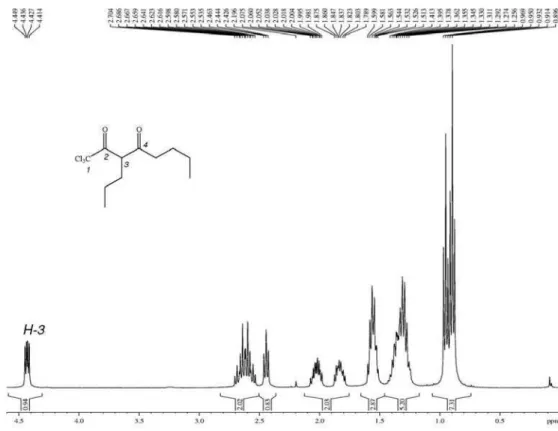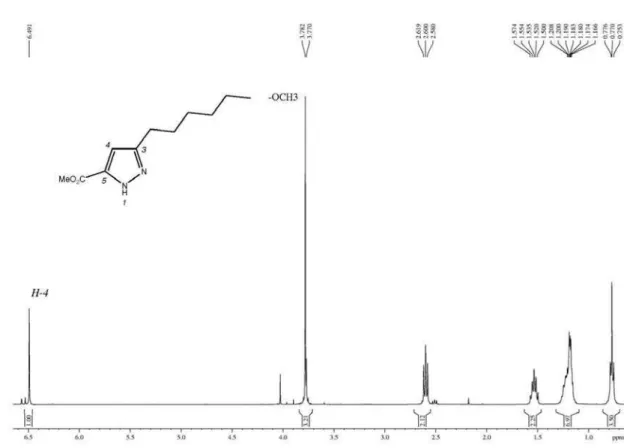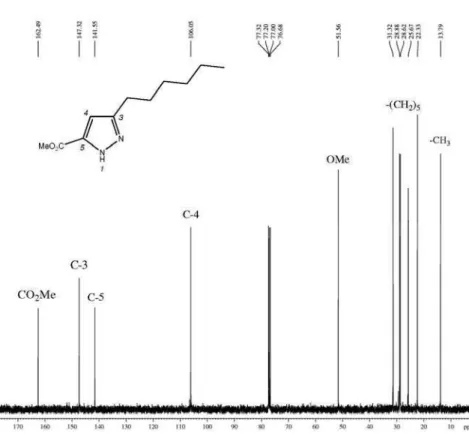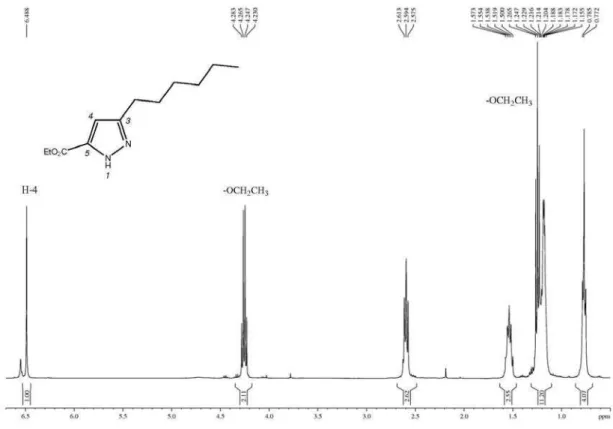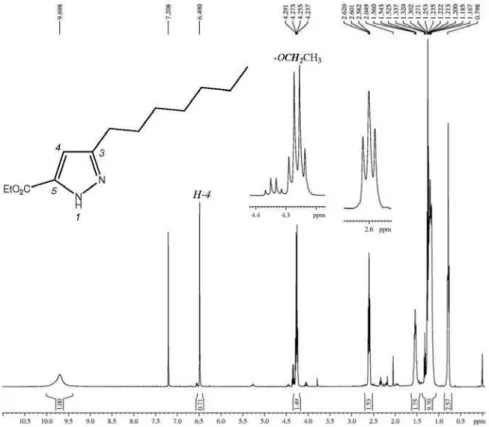Short Report
S
J. Braz. Chem. Soc., Vol. 24, No. 12, 2059-2065, 2013. Printed in Brazil - ©2013 Sociedade Brasileira de Química 0103 - 5053 $6.00+0.00 http://dx.doi.org/10.5935/0103-5053.20130237
*e-mail: alex.fcf@ufsm.br
Synthesis of Fatty Trichloromethyl-
β
-diketones and New 1
H-
Pyrazoles as
Unusual FAMEs and FAEEs
Alex F. C. Flores,*,a Rogerio F. Blanco,b Alynne A. Souto,a Juliana L. Malavoltaa and
Darlene C. Floresa
aDepartamento de Química, Universidade Federal de Santa Maria, 97105 900 Santa Maria-RS, Brazil
bFaculdade de Farmácia, União de Ensino do Sudoeste do Paraná (UNISEP),
85660-000 Dois Vizinhos-PR, Brazil
A síntese eficiente de novas 1,1,1-tricloro-4-metoxi-3-alquen-2-onas graxas [Cl3CC(O)C(R
2)=C(R1)OMe, onde R1 = n-hexil, heptil, nonil, undecil, tridecil e R2 = H] e
1,1,1-tricloro-2,4-alkanediones [Cl3CC(O)CHR2C (O) R1, onde R1 = n-pentil e R2 = Me, R1 = Et e
R2 = n-butil, R1 = n-butil e R2 = n-propil] é apresentada, com bons rendimentos (85-95%) a partir da
acilação dos respectivos acetais com cloreto de tricloroacetila. As 1,1,1-tricloro-4-metoxi-3-alquen-2-onas e 1,1,1-tricloro-2,4-alkanediones graxas reagem com cloridrato de hidrazina produzindo os respectivos 1H-pirazol-5-carboxilatos, uma classe de novos ésteres metílicos (FAMEs) e etílicos (FAEEs) graxos não comuns. As estruturas moleculares dos compostos sintetizados foram confirmadas por análise elementar e ressonância magnética nuclear (NMR) de 1H e 13C. As
1,1,1-tricloro-4-metoxi-3-alquen-2-onas graxas e seus derivados 1H-pirazol-5-carboxilatos são novos oleoquímicos com propriedades diferenciadas e potencialmente interessantes.
The efficient synthesis of new fatty 1,1,1-trichloro-4-methoxy-3-alken-2-ones [Cl3CC(O)C(R
2)=C(R1)OMe, where R1 = n-hexyl, heptyl, nonyl, undecyl, tridecyl and R2 = H] and
1,1,1-trichloro-2,4-alkanediones [Cl3CC(O)CHR
2C(O)R1, where R1 = n-pentyl and R2 = Me,
R1 = Et and R2 = n-butyl, R1 = n-butyl and R2 = n-propyl] in good yields (85-95%) from acetal
acylation with trichloroacetyl chloride is reported. The fatty 1,1,1-trichloro-4-methoxy-3-alken-2-ones and 1,1,1-trichloro-2,4-alkanediones were reacted with hydrazine hydrochloride, leading to respective 1H-pyrazole-5-carboxylates, unusual class of fatty acid methyl (FAMEs) and ethyl (FAEEs) esters. Their structures were confirmed by elemental analysis and 1H and 13C nuclear
magnetic resonance (NMR). The fatty 1,1,1-trichloro-4-methoxy-3-alken-2-ones and 1H-pyrazole derivatives are new oleochemicals with potentially interesting and differential properties.
Keywords: fatty ketones, acylation, fatty 1H-pyrazoles
Introduction
We have developed a general method for synthesizing a large number of 1,1,1-trihalomethyl-4-alkoxy-3-alken-2-ones, important halogen-containing building blocks, and we have demonstrated their usefulness in bioactive heterocyclic synthesis.1–3 These 1,3-dielectrophilic precursors have been used as a 3-atom block for the synthesis of 5-, 6- and 7-member heterocycles.4–6 Conventionally, enol ethers have been prepared from symmetrical ketone or aldehyde acetals. However, the isolation of these enol ethers
involves a tedious distillation process and in some cases (e.g., those derived from asymmetrical ketones) a mixture of kinetic and thermodynamic enol ethers is obtained.7,8 Our method, with in situ generating of enol ether, offers a convenient alternative to produce acylated regiospecific derivatives 1,1,1-trihalomethyl-4-alkoxy-3-alken-2-ones. Moreover, the transformation of the trichloromethyl group under mild conditions into carboxylic groups prompted us to devote special attention to these substrates.9,10
Synthesis of Fatty Trichloromethyl-β-diketones and New 1H-Pyrazoles as Unusual FAMEs and FAEEs J. Braz. Chem. Soc.
2060
in the agrochemical and pharmaceutical industries.11–13 Systematic investigations of this class of heterocycle have revealed that pyrazole-containing pharmacoactive agents play an important role in medicinal chemistry, leading to further research on the chemistry of this heterocycle.14–16
On the other hand, fatty substances are important in the food, pharmaceutical, personal care and paint industries.17–19 There is a constant commitment to developing new surfactants and detergents with potentially interesting properties.20,21 As a continuation of our research project on the synthetic potential of acetal acylating method, it is here reported the preparation of a series of new fatty 1,1,1-trichloro-4-alkoxy-3-alken-2-ones derived from fatty ketones and their conversion into 1H-pyrazole-carboxylate derivatives substituted with a long fatty chain, which are unusual fatty acid methyl (FAMEs) and ethyl (FAEEs) esters.
Results and Discussion
Dimethoxy ketals 1a-g were synthesized from the acetalization of the respective fatty ketones a-g with trimethylorthoformate in the presence of p-toluenesulfonic acid.19 The trichloroacylation reactions were carried out in chloroform and pyridine at 30 to 50 °C for 12 h as outlined in Scheme 1. Two equivalents of acylating agent per acetal were required to obtain the fatty 1,1,1-trichloro-4-methoxy-3-alken-2-ones 2a-g since one molecule of the acylating reagent promotes the formation of enol ether by trapping a methoxy group from acetal, and the second molecule of acylating reagent promotes the formation of C−C bonds. As previously reported, acetals of alkyl methyl ketones are always acylated at methyl sites.22 The acylated products 2a-e were obtained as black oil in very good yields of 85-95% (see Supplementary Information (SI) section, Table S1) and high purity (Scheme 1).
From alkyl methyl ketones (alken-2-ones), acylated products were obtained as
1,1,1-trichloro-4-methoxy-3-alken-2-ones without hydrolysis products from the work-up of acid water solutions. However, acylated products from octan-3-one and nonan-5-one were obtained as the respective trichloromethyl-β-diketones (3f,g). A mixture of 1,1,1-trichloro-3-methylnonan-2,4-dione (3f) and 1,1,1-trichloro-3-butylhexan-2,4-dione (3f’) was obtained from octan-3-one, and 1,1,1-trichloro-3-propyloctan-2,4-dione (3g) was obtained from nonan-5-one. During the acylation of 3,3-dimethoxyoctane with trichloroacetyl chloride, there was a preference for reactions at ethyl sites, leading to 3f in larger quantities than the isomer 3f’, demonstrating that the reaction had some degree of regioselectivity, probably for steric reasons as the reaction selects the lowest substituent between the carbonyl groups. The large sterical volume of the trichloromethyl group is likely one of the factors that prompted hydrolysis of 1,1,1-trichloro-4-methoxy-3-alken-2-ones substituted at position-3 and could help explain the preference of the respective trichloromethyl diketones for nonplanar keto-keto forms (Scheme 2).23
The structures of acylated products were characterized based on their nuclear magnetic resonance (NMR) spectra. The 1H NMR signal of the vinylic hydrogen for pattern H-3 of the 1,1,1-trichloro-4-methoxy-3-alken-2-one 3a appeared during high field analysis, d 5.9 ppm, and the spectrum showed the characteristic signals of the fatty alkyl chain: a triplet at d 2.7 ppm (2H, 5-CH2), a multiplet at d 1.5 ppm (2H, 6-CH2), the broad signal from the inner −CH2− at d 1.25 ppm, and the triplet from the terminal methyl at d 0.8 ppm. Further support for fatty acylated products was provided by the 13C NMR spectra. Pattern 3a showed high field signals from carbonyl C-2 and enol ether C-4 at d 179.8 and 183.9 ppm, respectively. There was a signal from vinylic C-3 at d 89.6 ppm, a short signal from CCl3 at d 98.05 ppm, an intense signal from the methoxy group at d 56.1 ppm, signals from methylenes at 22-34 ppm, and a methyl signal at d 13 ppm from the fatty alkyl chain. For tricloromethyl-β-diketones, the 1H NMR spectrum showed
Flores et al. 2061 Vol. 24, No. 12, 2013
signals from H-3 at 4.5 ppm, for 3b as a quartet with JHH 6.8 Hz, together with the methyl doublet (JHH 6,8 Hz), demonstrating the presence of the keto form in CDCl3 solution. Signals from the C5 chain were also detected. For 3b’, the H-3 signal appeared as a doublet of doublets (JHH 8.6 and 5.5 Hz) and the signals from alkyl chains were hidden by those from the predominant product (Scheme 2). The same pattern was observed in the 1H NMR spectrum from 3d, in winch the signal from H-3 was a doublet of doublets (JHH 8.8 and 5.2 Hz) and the spectrum showed all of the signals from 4-propyl and 3-butyl substituents. The NMR data for the fatty trichlomethylketones obtained are shown in the SI section.
Cyclization of 1,3-dielectrophilic precursors 2a-g and 3f,g with hydrazine hydrochloride proceeded smoothly in alcohol (methanol or ethanol) at reflux for 8 h to produce pyrazole-5-carboxylic esters 4, 5a-g in isolated yields of 93-96% (Table 1). After completion of the reaction, solvent was evaporated and the product was dried in a desiccator with anhydrous CaCl2 (Scheme 3).
Mechanistically, cyclocondensation between precursors 2 and hydrazine hydrochloride proceeds via conjugate
addition of nitrogen into the C-4 of 1,1,1-trichloro-4-methoxy-3-alken-2-ones. Then, one molecule of methanol is eliminated to give the enaminoketone intermediate, which isomerizes to thermodynamically more stable hydrazone. Subsequent cyclization affords the 5-trichloromethyl-5-hydroxy-4,5-dihydro-1H-pyrazole intermediates, which are unstable in alcohol medium.24 Then, one molecule of water is eliminated to give the aromatic 5-trichloromethyl-1H-pyrazole intermediate. Further elimination of chloride with the aid of the adjacent nitrogen atom leads to reactive intermediate I, which is attacked by water in the reaction medium, leading to the formation of an acid chloride that reacts with the solvent used in the reaction (MeOH or EtOH) (Scheme 4).
The 1H-pyrazole-5-carboxylates were identified based on NMR spectroscopy. The 1H NMR spectrum showed the characteristic signals of the fatty alkyl chain: a triplet at d 2.7 ppm (2H, 5-CH2), a multiplet at d 1.5 ppm (2H, 6-CH2), the broad signal from the inner −CH2− at d 1.25 ppm and the triplet from the terminal methyl at d 0.8 ppm. The signal from H-4 on the pyrazole ring appeared at d 6.5-6.6 ppm. The 13C NMR spectra displayed the trichloromethylcarbon as a characteristic small signal at approximately d 102.7; furthermore, the signals for pyrazole carbons C-3, C-4 and
Scheme 2. Trichloroacetylation of 3,3-dimethoxyoctane (1f).
Table 1. Yields of the compounds 4a-g and 5a-g
Compound R1 R2 R Yield / %
4a n-C6H13 H Me 95
4b n-C7H15 H Me 93
4c n-C9H19 H Me 96
4d n-C11H23 H Me 93
4e n-C13H27 H Me 93
4f n-C5H11 Me Me 65
4g n-Bu n-Pr Me 95
5a n-C6H13 H Et 96
5b n-C7H15 H Et 95
5c n-C9H19 H Et 95
5d n-C11H23 H Et 90
5e n-C13H27 H Et 95
5f n-C5H11 Me Et 62
5g n-Bu n-Pr Et 95
Scheme 3. Synthesis of fatty 1H-pyrazole-5-carboxylates from
Synthesis of Fatty Trichloromethyl-β-diketones and New 1H-Pyrazoles as Unusual FAMEs and FAEEs J. Braz. Chem. Soc.
2062
C-5 appeared at d 147, 106 and 141 ppm, respectively. For compounds substituted at C-4, the carbon C-4 was deshielded to 122 ppm and C-5 was shielded to 136 ppm. The signal from the carboxyl carbon appeared at 162 ppm.
Conclusion
In conclusion, we have established the versatility of the acetal acylation process for synthesizing fatty 1,1,1-trichloro-4-methoxy-3-alken-2-ones, which are versatile building blocks for heterocyclic compounds. It was found that trichloromethylated precursors react with hydrazine hydrochloride, leading to new methyl or ethyl 1H-pyrazole-5-carboxylates, fatty substances with potentially interesting properties.
Experimental
Unless indicated otherwise, all common reagents were used as obtained from commercial suppliers without further purification. All melting points were measured using a Reichert-Thermovar apparatus. Listed yields are of isolated compounds. 1H and 13C NMR spectra were acquired on a Bruker DPX 200 or Bruker DPX 400 spectrometer (1H at 200.13 or 400.13 MHz and 13C at 50.32 or 100.63 MHz) at 300 K, using 5 mm sample tubes, and with a digital resolution of ± 0.01 ppm. CDCl3 was used as a solvent with TMS (tetramethylsilane) as the internal standard.
General procedure for 1,1,1-trichloro-4-methoxy-3-alken-2-ones (2a-g)
To a stirred solution of dimethoxy acetal derived from fatty ketones 1a-g (30 mmol) and pyridine (60 mmol,
4.8 g) in CHCl3 (30 mL) kept at 0 °C, a solution of trichloroacetyl chloride (60 mmol, 6.8 mL) in CHCl3 (20 mL) was added dropwise at −5 °C. The mixture was stirred for 8-12 h at room temperature (30-50 °C). After, the mixture was quenched with a 2 mol L-1 HCl solution (30 mL), the organic layer was separated and dried with Na2SO4, the solvent was evaporated, and the residue was distilled to remove methyl trichloroacetate. The products 2a-e were obtained as black oil with high purity, and all are inedited. Yields, NMR data and spectra for 1,1,1-trichloro-4-methoxy-3-alken-2-ones 2a-e are presented in the SI section.
General procedure for 1H-pyrazole-5-carboxylate derivatives (4, 5)
A mixture of one precursor 2a-e or 3f,g (10 mmol) and NH2NH2.HCl (12 mmol, 0.82 g) in 10 mL alcohol (MeOH or EtOH) was stirred under reflux for 4 to 8 h. Then solvent was evaporated, the residue was dissolved in CH2Cl2 (20 mL) and washed with water (15 mL) twice, and the organic layer was dried with Na2SO4. After evaporation of the solvent, the residues were obtained as reddish orange oils (R = hexyl, heptyl and nonyl) or brown greases (R = undecyl and tridecyl). Spectroscopic data for derivatives 1H-pyrazole carboxylate 4a-g and 5a-g and the full data series can be seen in the SI section.
Methyl 3-hexyl-1H-pyrazole-5-carboxylate (4a): yield 95%, orange oil; 1H NMR (400 MHz, CDCl
3) d 6.49 (s, 1H, H4), 3.78 (s, 3H, OMe), 2.60 (t, 2H, H6), 1.53 (qu, 2H, H7), 1.18 (m, 6H, −(CH2)3−), 0.77 (t, 3H, Me); 13C NMR (100 MHz, CDCl3) d 162.5 (CO2Me), 147.3 (C3), 141.5 (C5), 106.0 (C4), 51.5 (OMe), 31.3, 28.8, 28.6, 25.7, 22.3
Flores et al. 2063 Vol. 24, No. 12, 2013
(CH2), 13.8 (Me); MS (70 eV) m/z 211 (M+ + 1, 10), 210 (M+, 60); anal. calcd. for C
11H18N2O2: C, 62.83; H, 8.63; found C, 62.7; H, 8.7.
Methyl 3-heptyl-1H-pyrazole-5-carboxylate (4b): yield 93%, red orange oil; 1H NMR (400 MHz, CDCl
3) d 6.49 (s, 1H, H4), 3.77 (s, 3H, OMe), 2.61 (t, 2H, H6), 1.52 (qu, 2H, H7), 1.18 (m, 8H, −(CH2)4−), 0.77 (t, 3H, Me);
13C NMR (100 MHz, CDCl3) d 162.3 (CO2Me), 147.3 (C3), 141.4 (C5), 106.1 (C4), 51.7 (OMe), 31.6, 28.97, 28.93, 28.8, 25.6, 22.5 (CH2), 13.9 (Me); MS (70 eV) m/z 225 (M+ + 1, 10), 224 (M+, 58); anal. calcd. for C
12H20N2O2: C, 64.26; H, 8.99; found C, 64.5; H, 8.9.
Methyl 3-nonyl-1H-pyrazole-5-carboxylate (4c): yield 96%, red orange oil; 1H NMR (400 MHz, CDCl
3) d 6.48 (s, 1H, H4), 3.77 (s, 3H, OMe), 2.60 (t, 2H, H6), 1.52 (qu, 2H, H7), 1.18 (m, 12H, −(CH2)6−), 0.78 (t, 3H, Me);
13C NMR (100 MHz, CDCl3) d 162.5 (CO2Me), 147.2 (C3), 141.6 (C5), 106.0 (C4), 51.5 (OMe), 31.7, 29.3, 29.16, 29.12, 28.99 28.93, 25.6, 22.5 (CH2), 13.9 (Me); MS (70 eV) m/z 253 (M+ + 1, 12), 252 (M+, 65); anal. calcd. for C
14H24N2O2: C, 66.63; H, 9.59; found C, 66.8; H, 9.5.
Methyl 3-undecyl-1H-pyrazole-5-carboxylate (4d): yield 93%, brown grease; 1H NMR (400 MHz, CDCl
3) d 6.6 (s, 1H, H4), 3.77 (s, 3H, OMe), 2.70 (t, 2H, H6), 1.65 (qu, 2H, H7), 1.28 (m, 16H, − (CH2)8−), 0.88 (t, 3H, Me);
13C NMR (100 MHz, CDCl3) d 162.5 (CO2Me), 147.2 (C3), 141.6 (C5), 106.0 (C4), 51.5 (OMe), 31.8, 29.57, 29.55, 29.46, 29.27, 29.09, 29.07, 26.1, 22.6 (CH2), 14.0 (Me); MS (70 eV) m/z 281 (M+ + 1, 9), 280 (M+, 60); anal. calcd. for C16H28N2O2: C, 68.53; H, 10.06; found C, 68.3; H, 10.1.
Methyl 3-tridecyl-1H-pyrazole-5-carboxylate (4e): yield 93%, brown grease; 1H NMR (400 MHz, CDCl
3) d 6.59 (s, 1H, H4), 3.77 (s, 3H, OMe), 2.69 (t, 2H, H6), 1.62 (qu, 2H, H7), 1.18 (m, 20H, −(CH2)10−), 0.88 (t, 3H, Me);
13C NMR (100 MHz, CDCl3) d 161.8 (CO2Me), 148.1 (C3), 141.2 (C5), 106.2 (C4), 51.7 (OMe), 31.8, 29.61, 29.58, 29.46, 29.28, 29.10, 29.07, 26.1, 22.6 (CH2), 14.0 (Me); MS (70 eV) m/z 309 (M+ + 1, 15), 308 (M+, 60); anal. calcd. for C18H32N2O2: C, 70.09; H, 10.46; found C, 70.0; H, 10.7.
Methyl 4-methyl-3-pentyl-1H-pyrazole-5-carboxylate (4f): yield 65%, red orange oil; 1H NMR (400 MHz, CDCl
3) d 3.89 (s, 3H, OMe), 2.60 (s, 2H, H6), 2.22 (t, 3H, 4-CH3), 1.61 (qu, 2H, H7), 1.18 (m, 4H, −(CH2)2−), 0.89 (t, 3H, Me); 13C NMR (100 MHz, CDCl
3) d 162.0 (CO2Me), 148.2 (C3), 135.8 (C5), 117.5 (C4), 51.6 (OMe), 31.4, 28.6, 25.2, 22.3 (CH2), 13.9 (Me), 8.57 (4-Me); MS (70 eV) m/z 211
(M+ + 1, 6), 210 (M+, 71); anal. calcd. for C
11H18N2O2: C, 62.83; H, 8.63; found C, 62.6; H, 8.5.
Methyl 3-butyl-4-propyl-1H-pyrazole-5-carboxylate (4g): yield 95%, red orange oil; 1H NMR (400 MHz, CDCl3) d 3.81 (s, 3H, OMe), 2.56 (q, 4H, −(CH2)2−), 1.55 (m, 2H, −CH2−), 1.48 (m, 2H, −CH2−), 1.30 (m, 2H, −CH2−), 0.85 (t, 3H, Me), 0.83 (t, 3H, Me);
13C NMR (100 MHz, CDCl3) d 162.1 (CO2Me), 147.1 (C3), 136.1 (C5), 122.2 (C4), 51.4 (OMe), 31.3, 25.2, 24.7, 24.0, 22.3 (CH2), 13.9, 13.6 (Me); MS (70 eV) m/z 225 (M+ + 1, 8), 224 (M+, 65); anal. calcd. for C
12H20N2O2: C, 64.26; H, 8.99; found C, 64.3; H, 9.1.
Ethyl 3-hexyl-1H-pyrazole-5-carboxylate (5a): yield 96%, orange oil; 1H NMR (400 MHz, CDCl
3) d 6.49 (s, 1H, H4), 4.25 (q, 2H, OCH2), 2.59 (t, 2H, H6), 1.54 (qu, 2H, H7), 1.25 (t, 3H, Me), 1.19 (m, 6H, −(CH2)3−), 0.77 (t, 3H, Me); 13C NMR (100 MHz, CDCl
3) d 161.9 (CO2Et), 147.7 (C3), 141.4 (C5), 106.1 (C4), 60.8 (OCH2), 31.4, 28.9, 28.7, 25.8, 22.4 (CH2), 14.1 (Me), 13.8 (Me); MS (70 eV) m/z 225 (M+ + 1, 12), 224 (M+, 97); anal. calcd. for C 12H20N2O2: C, 64.26; H, 8.99; found C, 64.4; H, 9.2.
Ethyl 3-heptyl-1H-pyrazole-5-carboxylate (5b): yield 95%, red orange oil; 1H NMR (400 MHz, CDCl
3) d 6.49 (s, 1H, H4), 4.26 (q, 2H, OCH2), 2.60 (t, 2H, H6), 1.54 (qu, 2H, H7), 1.25 (t, 3H, Me), 1.19 (m, 8H, −(CH2)4−), 0.77 (t, 3H, Me); 13C NMR (100 MHz, CDCl
3) d 162.0 (CO2Et), 147.5 (C3), 141.6 (C5), 106.0 (C4), 60.7 (OCH2), 31.6, 29.02, 28.99, 28.87, 25.84, 22.5 (CH2), 14.2 (Me), 13.9 (Me); MS (70 eV) m/z 239 (M+ + 1, 9), 238 (M+, 70); anal. calcd. for C 13H22N2O2: C, 65.51; H, 9.30; found C, 65.2; H, 9.5.
Ethyl 3-nonyl-1H-pyrazole-5-carboxylate (5c): yield 95%, red orange oil; 1H NMR (400 MHz, CDCl
3) d 6.51 (s, 1H, H4), 4.28 (q, 2H, OCH2), 2.60 (t, 2H, H6), 1.56 (qu, 2H, H7), 1.28 (t, 3H, Me), 1.18 (m, 12H, −(CH2)6−), 0.80 (t, 3H, Me); 13C NMR (100 MHz, CDCl
3) d 161.7 (CO2Et), 148.3 (C3), 141.0 (C5), 106.3 (C4), 60.8 (OCH2), 31.8, 29.4, 29.23, 29.17, 29.05, 29.04, 26.14, 22.5 (CH2), 14.2 (Me), 13.9 (Me); MS (70 eV) m/z 267 (M+ + 1, 12), 266 (M+, 70); anal. calcd. for C
15H26N2O2: C, 67.63; H, 9.84; found C, 67.3; H, 10.0.
Ethyl 3-undecyl-1H-pyrazole-5-carboxylate (5d): yield 90%, brown grease; 1H NMR (400 MHz, CDCl
3) d 6.6 (s, 1H, H4), 4.37 (s, 2H, OCH2), 2.70 (t, 2H, H6), 1.65 (qu, 2H, H7), 1.37 (t, 3H, Me), 1.28 (m, 16H, −(CH2)8−), 0.89 (t, 3H, Me); 13C NMR (100 MHz, CDCl
Synthesis of Fatty Trichloromethyl-β-diketones and New 1H-Pyrazoles as Unusual FAMEs and FAEEs J. Braz. Chem. Soc.
2064
29.57, 29.55, 29.46, 29.27, 29.09, 29.07, 26.1, 22.6 (CH2), 14.2 (Me), 14.0 (Me); MS (70 eV) m/z 295 (M+ + 1, 17), 294 (M+, 90); anal. calcd. for C
17H30N2O2: C, 68.53; H, 10.06; found C, 68.3; H, 10.1.
Ethyl 3-tridecyl-1H-pyrazole-5-carboxylate (5e): yield 95%, brown grease; 1H NMR (400 MHz, CDCl
3) d 6.59 (s, 1H, H4), 4.36 (s, 2H, OCH2), 2.69 (t, 2H, H6), 1.62 (qu, 2H, H7), 1.35 (t, 3H, Me), 1.25 (m, 20H, −(CH2)10−), 0.88 (t, 3H, Me); 13C NMR (100 MHz, CDCl
3) d 161.8 (CO2Et), 148.1 (C3), 141.2 (C5), 106.2 (C4), 60.8 (OCH2), 31.8, 29.61, 29.58, 29.46, 29.28, 29.10, 29.07, 26.1, 22.6 (CH2), 14.2 (Me), 14.0 (Me); MS (70 eV) m/z 323 (M+ + 1, 17), 322 (M+, 93); anal. calcd. for C
19H34N2O2: C, 70.76; H, 10.63; found C, 70.2; H, 10.9.
Ethyl 4-methyl-3-pentyl-1H-pyrazole-5-carboxylate (5f):
yield 62%, red orange oil; 1H NMR (400 MHz, CDCl 3) d 4.36 (s, 2H, OCH2), 2.63 (s, 2H, H6), 2.23 (t, 3H, 4-CH3), 1.63 (qu, 2H, H7), 1.37 (t, 3H, Me), 1.18 (m, 4H, −(CH2)2−), 0.89 (t, 3H, Me); 13C NMR (100 MHz, CDCl
3) d 162.0 (CO2Et), 148.2 (C3), 135.8 (C5), 117.5 (C4), 60.3 (OCH2), 31.4, 28.6, 25.2, 22.3 (CH2), 14.2 (Me), 13.9 (Me), 8.57 (4-Me); MS (70 eV) m/z 239 (M+ + 1, 8), 238 (M+, 70); anal. calcd. for C12H20N2O2: C, 64.26; H, 8.99; found C, 64.0; H, 9.2.
Ethyl 3-butyl-4-propyl-1H-pyrazole-5-carboxylate (5g):
yield 95%, red orange oil; 1H NMR (400 MHz, CDCl 3) d 4.36 (q, 2H, OCH2), 2.63 (q, 4H, −(CH2)2−), 1.62 (m, 2H, −CH2−), 1.53 (m, 2H, −CH2−), 1.38 (m, 2H, −CH2−), 0.85 (t, 3H, Me), 0.83 (t, 3H, Me); 13C NMR (100 MHz, CDCl3) d 161.5 (CO2Et), 148.0 (C3), 135.6 (C5), 122.3 (C4), 60.5 (OCH2), 31.3, 25.3, 24.9, 24.1, 22.4 (CH2), 14.2 13.9, 13.7 (Me); MS (70 eV) m/z 239 (M+ + 1, 15), 238 (M+, 85); anal. calcd. for C
13H22N2O2: C, 65.51; H, 9.30; found C, 65.1; H, 9.8.
Supplementary Information
Supplementary material (spectra data and spectra of synthesized compounds) is available free of charge at http://jbcs.sbq.org.br as PDF file.
Acknowledgments
The authors are grateful for the financial support f r o m C o n s e l h o N a c i o n a l d e D e s e nvo l v i m e n t o Científico e Tecnológico (CNPq, Universal grant 6577818477962764-01), and Fundação de Amparo à Pesquisa do Estado do Rio Grande do Sul (FAPERGS,
PqG grant 1016236). The fellowships from CNPq (A. A. Souto and J. L. Malavolta) are also acknowledged.
References
1. Martins, M. A. P.; Cunico, W.; Pereira, C. M. P.; Sinhorin, A. P.; Flores, A. F. C.; Bonacorso, H. G.; Zanatta, N.; Curr.
Org. Chem.2004, 1, 391.
2. Flores, A. F. C.; Flores, D. C.; Oliveira, G.; Pizzuti, L.; Silva, R. M. S.; Martins, M. A. P.; Bonacorso, H. G.; J. Braz. Chem.
Soc. 2008, 19, 184.
3. Gressler, V.; Moura, S.; Flores, A. F C.; Flores, D.C.; Colepicolo, P.; Pinto, E.; J. Braz. Chem Soc.2010, 21, 1477. 4. Flores, A. F. C.; Malavolta, J. L.; Souto, A. A.; Goularte, R. B.;
Flores, D. C.; Piovesan, L. A.; J. Braz. Chem Soc.2013, 24, 580.
5. Flores, A. F. C.; Piovesan, L. A.; Pizzuti, L.; Flores, D. C.; Malavolta, J. L.; Martins, M. A. P.; J. Heterocycl. Chem. 2013,
in press, DOI: xxx.
6. Zanatta, N.; Faoro, D.; Fernandes, L. S.; Brondani, P. B.; Flores, D. C.; Flores, A. F. C.; Bonacorso, H. G.; Martins, M. A. P.;
Eur. J. Org. Chem.2008, 34, 5832.
7. Hesse, G.; Houben-Weyl,vol. 6/1d; George Thieme Verlag: Stuttgart, 1978, p. 173.
8. Gassman, P. G.; Burns, S. J.; Pfister, K. B.; J. Org. Chem.1993,
58, 1449.
9. Bonacorso, H. G.; Correa, M. S.; Porte, L. M. F.; Pittalunga, E. P.; Zanatta, N.; Martins, M. A. P.; Tetrahedron Lett.2012,
53, 5488.
10. Martins, M. A. P.; Flores, A. F. C.; Freitag, R.; Zanatta, N.; Rosa, A. O.; Bonacorso, H. G.; J. Heterocycl. Chem.1999, 36, 217. 11. Chauhan, A.; Sharma, P. K.; Kaushik, N.; Int. J. ChemTech Res.
2011, 3, 11.
12. Aggarwal, R.; Kumar, R.; Kumar, S.; Garg, G.; Mahajan, R.; Sharma, J.; J. Fluorine Chem.2011, 132, 965.
13. Maspero, A.; Giovenzana, G. B.; Monticelli, D.; Tagliapietra, S.; Palmisano, G.; Penoni, A.; J. Fluorine Chem.2012, 139, 53. 14. Martins, M. A. P.; Sinhorin, A. P.; Frizzo, C. P.; Buriol, L.;
Scapin, E.; Zanatta, N.; Bonacorso, H. G.; J. Heterocycl. Chem.
2013, 71, 71.
15. Ermolenko, M. S.; Guillou, S.; Janin, Y. L.; Tetrahedron2013,
69, 257.
16. Kryl’skii, D. V.; Shikhaliev, Kh. S.; Chuvashlev, A. S.; Russ. J.
Org. Chem. 2010, 46, 410.
17. Farfán, M.; Villalón, M. J.; Ortíz, M. E.; Nieto, S.; Bouchon, P.;
Food Chem. 2013, 139, 571; Nestel, P.; Noakes, M.; Clifton, P.;
Lipids1996, 31, S65.
Flores et al. 2065 Vol. 24, No. 12, 2013
20. El-Sayed, R.; J. Surfactants Deterg. 2013, 16, 39.
21. Mishra, M.; Muthuprasanna, P.; Prabha, K. S.; SobhitaRani, P.; Babu, I. A. S.; Chandiran, I. S.; Arunachalam, G.; Shalini, S.;
Int. J. PharmTech Res. 2009, 1, 1354.
22. Martins, M. A. P.; Bastos, G. P.; Bonacorso, H. G.; Zanatta, N.; Flores, A. F. C.; Siqueira, G. M.; Tetrahedron Lett. 1999, 40, 4309.
23. Flores, A. F. C.; Martins, M. J.; Frigo, L. M.; Machado, P.; Campos, P. T.; Malavolta, J. L.; Synth. Commun.2011, 42, 727. 24. Martins, M. A. P.; Sinhorin, A. P.; Frizzo, C. P.; Buriol, L.;
Scapin, E.; Zanatta, N.; Bonacorso, H. G.; J. Heterocycl. Chem.
2013, 50, 70.
Supplementary Information
S
I
J. Braz. Chem. Soc., Vol. 24, No. 12, S1-S31, 2013.Printed in Brazil - ©2013 Sociedade Brasileira de Química 0103 - 5053 $6.00+0.00
*e-mail: alex.fcf@ufsm.br
Synthesis of Fatty Trichloromethyl-
β
-diketones and New 1
H-
Pyrazoles as
Unusual FAMEs and FAEEs
Alex F. C. Flores,*,a Rogerio F. Blanco,b Alynne A. Souto,a Juliana L. Malavoltaa and
Darlene C. Floresa
aDepartamento de Química, Universidade Federal de Santa Maria,
97105 900 Santa Maria-RS, Brazil
bFaculdade de Farmácia, União de Ensino do Sudoeste do Paraná (UNISEP),
85660-000 Dois Vizinhos-PR, Brazil
1H and 13C NMR data and spectra for
1,1,1-trichloro-4-methoxy-3-alken-2-ones (2a-e), trichloromethyl-β -diketones (3f,g) and 1H-pyrazole-5-carboxylates (4a-g, 5a-g) are shown. The 1H and 13C spectra were recorded
at 298 K on a Bruker DPX 400 spectrometer (1H at
400.13 MHz, 13C at 100.63 MHz) with digital resolution
of ± 0.01 ppm. All the chemical shifts are expressed in
Table S1. 1H NMR data for 1,1,1-trichloro-4-methoxy-3-alken-2-ones 2 and trichloromethyl-β-diketones 3 in CDCl
3,d in ppm, multiplicity, J in Hz
Compound, Yield / % H-3 H-5 H-6 Others Me OMe
2a, 85 5.96 2.78, t, 8.0 1.57, qui, 8.0 1.28-1.39 0.89, t, 6.8 3.79
2b, 92 5.97 2.78, t, 8.0 1.58, qui, 8.0 1.29-1.38 0.89, t, 6.8 3.79
2c, 95 5.97 2.78, t, 8.0 1.57, qui, 8.0 1.27-1.35 0.88, t, 6.8 3.79
2d, 92 5.95 2.77, t, 8.0 1.56, qui, 8.0 1.26-1.34 0.87, t, 6.8 3.78
2e, 90 5.96 2.78, t, 8.0 1.57, qui, 8.0 1.26-1.34 0.88, t, 6.8 3.79
3f, 69 4.47, q, 7.2 2.58, m, 6.8 1.58, m, 7.2 1.32, m 0.9, 0.88t −
3f’, 23 4.42, dd, 8.5, 5.2 −a −a − − −
3g, 89 4.43, dd, 8.9, 5.2 2.62, m 1.92, m 1.20-1.40 0.89, 0.96, t, t −
aOverlapping signals.
Table S2. 13C NMR data for for 1,1,1-trichloro-4-methoxy-3-alken-2-ones 2 and trichloromethyl-β- diketones 3 in CDCl
3, d in ppm
Compound C-1 C-2 C-3 C-4 OMe Others
2a 98.0 179.9 89.7 184.0 56.2 33.4; 31.4; 28.1; 26.9; 22.5; 13.9
2b 98.0 179.9 89.7 184.0 56.2 33.4; 31.7; 29.4; 28.9; 27.0; 22.5; 14.0
2c 98.0 179.9 89.7 184.0 56.2 33.4; 31.8; 29.4; 29.2; 26.9; 22.6; 14.0
2d 98.0 179.8 89.7 183.9 56.1 33.4; 31.8; 29.4; 29.2; 29.1; 26.9; 22.6; 14.0
2e 98.0 179.9 89.7 184.1 56.2 33.4; 31.9; 29.65; 29.62; 29.59; 29.5; 29.4; 29.3; 27.0; 22.6; 14.0
3f 96.1 186.7 52.5 203.5 − 40.5; 31.1; 23.0; 22.2; 16.3; 13.69
3f’ 96.1 185.2 58.6 203.3 − 40.5; 34.3; 31.0; 22.8; 29.6; 7.60
3g 94.4 185.2 58.7 203.5 − 40.7; 33.5; 25.4; 22.0; 21.0; 13.8; 13.7
ppm, 1H and 13C are reported with respect to internal TMS
(tetramethylsilane). 0.1 mol L-1 CDCl
3 solutions were used
except with compounds 2, 0.1 mol L-1 in DMSO-d 6. H-H
Synthesis of Fatty Trichloromethyl-β-diketones and New 1H-Pyrazoles as Unusual FAMEs and FAEEs J. Braz. Chem. Soc.
S2
Figure S1.1H NMR spectrum (400 MHz, CDCl
3) of 1,1,1-trichloro-4-methoxy-4-decen-2-one.
Figure S2. 1H NMR spectrum (400 MHz, CDCl
Flores et al. S3 Vol. 24, No. 12, 2013
Figure S3. 13C NMR (100 MHz, CDCl
3) spectrum of 1,1,1-trichloro-4-methoxy-4-decen-2-one.
Figure S4. 13C NMR DEPT135 spectrum (100 MHz, CDCl
Synthesis of Fatty Trichloromethyl-β-diketones and New 1H-Pyrazoles as Unusual FAMEs and FAEEs J. Braz. Chem. Soc.
S4
Figure S5. 1H NMR spectrum (400 MHz, CDCl
3) of 1,1,1-trichloro-4-methoxy-4-undecen-2-one in CDCl3.
Figure S6. 1H NMR spectrum (400 MHz, CDCl
Flores et al. S5 Vol. 24, No. 12, 2013
Figure S7. 13C NMR spectrum (100 MHz, CDCl
3) of 1,1,1-trichloro-4-methoxy-4-undecen-2-one.
Figure S8. 13C NMR DEPT135 spectrum (100 MHz, CDCl
Synthesis of Fatty Trichloromethyl-β-diketones and New 1H-Pyrazoles as Unusual FAMEs and FAEEs J. Braz. Chem. Soc.
S6
Figure S9. 1H NMR spectrum (400 MHz, CDCl
3) of 1,1,1-trichloro-4-methoxy-4-tridecen-2-one.
Figure S10. 1H NMR spectrum (400 MHz, CDCl
Flores et al. S7 Vol. 24, No. 12, 2013
Figure S11. 13C NMR spectrum (100 MHz, CDCl
3) of 1,1,1-trichloro-4-methoxy-4-tridecen-2-one.
Figure S12. 1H NMR spectrum (400 MHz, CDCl
Synthesis of Fatty Trichloromethyl-β-diketones and New 1H-Pyrazoles as Unusual FAMEs and FAEEs J. Braz. Chem. Soc.
S8
Figure S13. 13C NMR spectrum (100 MHz, CDCl
3) of 1,1,1-trichloro-4-methoxy-3-pentadecen-2-one (91%) + 1,1,1-trichloropentadecan-2-one (9%).
Figure S14. 13C NMR DEPT135 spectrum (100 MHz, CDCl
3) of 1,1,1-trichloro-4-methoxy-3-pentadecen-2-one (91%) + 1,1,1-trichloropentadecan-2-one
Flores et al. S9 Vol. 24, No. 12, 2013
Figure S15. 1H NMR spectrum (400 MHz, CDCl
3) of 1,1,1-trichloro-4-methoxy-3-heptadecen-2-one.
Figure S16. 1H NMR spectrum (400 MHz, CDCl
Synthesis of Fatty Trichloromethyl-β-diketones and New 1H-Pyrazoles as Unusual FAMEs and FAEEs J. Braz. Chem. Soc.
S10
Figure S17. 13C NMR spectrum (100 MHz, CDCl
3) of 1,1,1-trichloro-4-methoxy-3-heptadecen-2-one.
Figure S18. 13C NMR spectrum (100 MHz, CDCl
Flores et al. S11 Vol. 24, No. 12, 2013
Figure S19. 1H NMR spectrum (400 MHz, CDCl
3) of 1,1,1-trichloro-3-methylnonan-2,4-dione (ca. 75%) + 1,1,1-trichloro-3-butylhexan-2,4-dione (ca. 25%).
Figure S20. 1H NMR spectrum (400 MHz, CDCl
3) of 1,1,1-trichloro-3-methylnonan-2,4-dione + 1,1,1-trichloro-3-butylhexan-2,4-dione, expanded
Synthesis of Fatty Trichloromethyl-β-diketones and New 1H-Pyrazoles as Unusual FAMEs and FAEEs J. Braz. Chem. Soc.
S12
Figure S21. 13C NMR spectrum (100 MHz, CDCl
3) of 1,1,1-trichloro-3-methyl-2,4-nonan-2,4-dione (3f) + 1,1,1-trichloro-3-butylhexan-2,4-dione (3f’).
Figure S22. 1H NMR spectrum (400 MHz, CDCl
Flores et al. S13 Vol. 24, No. 12, 2013
Figure S23. 1H NMR spectrum (400 MHz, CDCl
3) of 1,1,1-trichloro-3-propyloctan-2,4-dione, expanded between 0-4.6 ppm.
Figure S24. 13C NMR spectrum (400 MHz, CDCl
Synthesis of Fatty Trichloromethyl-β-diketones and New 1H-Pyrazoles as Unusual FAMEs and FAEEs J. Braz. Chem. Soc.
S14
Figure S25.1H NMR spectrum (400 MHz, CDCl
3) of methyl 3-hexyl-1H-pyrazole-5-carboxylate.
Figure S26. 1H NMR spectrum (400 MHz, CDCl
Flores et al. S15 Vol. 24, No. 12, 2013
Figure S27. 13C NMR spectrum (100 MHz, CDCl
3) of methyl 3-hexyl-1H-pyrazole-5-carboxylate.
Figure S28. 1H NMR spectrum (400 MHz, CDCl
Synthesis of Fatty Trichloromethyl-β-diketones and New 1H-Pyrazoles as Unusual FAMEs and FAEEs J. Braz. Chem. Soc.
S16
Figure S29. 1H NMR spectrum (400 MHz, CDCl
3) of ethyl 3-hexyl-1H-pyrazole-5-carboxylate , expanded between 0.5-6.7 ppm.
Figure S30. 13C NMR spectrum (100 MHz, CDCl
Flores et al. S17 Vol. 24, No. 12, 2013
Figure S31. 1H NMR spectrum (400 MHz, CDCl
3) of methyl 3-heptyl-1H-pyrazole-5-carboxylate.
Figure S32. 13C NMR spectrum (100 MHz, CDCl
Synthesis of Fatty Trichloromethyl-β-diketones and New 1H-Pyrazoles as Unusual FAMEs and FAEEs J. Braz. Chem. Soc.
S18
Figure S33. 1H NMR spectrum (400 MHz, CDCl
3) of ethyl 3-heptyl-1H-pyrazole-5-carboxylate in CDCl3.
Figure S34. 13C NMR spectrum (400 MHz, CDCl
Flores et al. S19 Vol. 24, No. 12, 2013
Figure S35. 1H NMR spectrum (400 MHz, CDCl
3) of methyl 3-nonyl-1H-pyrazole-5-carboxylate.
Figure S36. 13C NMR spectrum (100 MHz, CDCl
Synthesis of Fatty Trichloromethyl-β-diketones and New 1H-Pyrazoles as Unusual FAMEs and FAEEs J. Braz. Chem. Soc.
S20
Figure S37. 1H NMR spectrum (400 MHz, CDCl
3) of ethyl 3-nonyl-1H-pyrazole-5-carboxylate.
Figure S38. 13C NMR spectrum (100 MHz, CDCl
Flores et al. S21 Vol. 24, No. 12, 2013
Figure S39. 1H NMR spectrum (400 MHz, CDCl
3) of ethyl 3-undecyl-1H-pyrazole-5-carboxylate.
Figure S40. 1H NMR spectrum (400 MHz, CDCl
Synthesis of Fatty Trichloromethyl-β-diketones and New 1H-Pyrazoles as Unusual FAMEs and FAEEs J. Braz. Chem. Soc.
S22
Figure S41. 13C NMR spectrum (100 MHz, CDCl
3) of ethyl 3-undecyl-1H-pyrazole-5-carboxylate in CDCl3.
Figure S42. 13C NMR spectrum (100 MHz, CDCl
Flores et al. S23 Vol. 24, No. 12, 2013
Figure S43. 1H NMR spectrum (400 MHz, CDCl
3) of ethyl 3-tridecyl-1H-pyrazole-5- carboxylate.
Figure S44. 1H NMR spectrum (400 MHz, CDCl
Synthesis of Fatty Trichloromethyl-β-diketones and New 1H-Pyrazoles as Unusual FAMEs and FAEEs J. Braz. Chem. Soc.
S24
Figure S45. 13C NMR spectrum (100 MHz, CDCl
3) of ethyl 3-tridecyl-1H-pyrazole-5- carboxylate.
Figure S46. 13C NMR spectrum (100 MHz, CDCl
Flores et al. S25 Vol. 24, No. 12, 2013
Figure S47. 1H NMR spectrum (400 MHz, CDCl
3) of methyl 4-methyl-3-pentyl-1H-pyrazole-5-carboxylate + methyl 4-butyl-3-ethyl-1H
-pyrazole-5-carboxylate.
Figure S48. 1H NMR spectrum (400 MHz, CDCl
3) of methyl 4-methyl-3-pentyl-1H-pyrazole-5-carboxylate + methyl 4-butyl-3-ethyl-1H
Synthesis of Fatty Trichloromethyl-β-diketones and New 1H-Pyrazoles as Unusual FAMEs and FAEEs J. Braz. Chem. Soc.
S26
Figure S49. 13C NMR spectrum (100 MHz, CDCl
3) of methyl 4-methyl-3-pentyl-1H-pyrazole-5-carboxylate + methyl 4-butyl-3-ethyl-1H
-pyrazole-5-carboxylate.
Figure S50. 13C NMR spectrum (400 MHz, CDCl
3) of methyl 4-methyl-3-pentyl-1H-pyrazole-5-carboxylate + methyl 4-butyl-3-ethyl-1H
Flores et al. S27 Vol. 24, No. 12, 2013
Figure S51. 1H NMR spectrum (400 MHz, CDCl
3) of ethyl 4-methyl-3-pentyl-1H-pyrazole-5-carboxylate + ethyl 4-butyl-3-ethyl-1H-pyrazole-5-carboxylate.
Figure S52. 1H NMR spectrum (400 MHz, CDCl
3) of ethyl 4-methyl-3-pentyl-1H-pyrazole-5-carboxylate + ethyl 4-butyl-3-ethyl-1H
Synthesis of Fatty Trichloromethyl-β-diketones and New 1H-Pyrazoles as Unusual FAMEs and FAEEs J. Braz. Chem. Soc.
S28
Figure S53. 13C NMR spectrum (100 MHz, CDCl
3) of ethyl 4-methyl-3-pentyl-1H-pyrazole-5-carboxylate + ethyl 4-butyl-3-ethyl-1H-pyrazole-5-carboxylate.
Figure S54. 13C NMR spectrum (100 MHz, CDCl
Flores et al. S29 Vol. 24, No. 12, 2013
Figure S55. 1H NMR spectrum (400 MHz, CDCl
3) of methyl 3-butyl-4-propyl-1H-pyrazole-5-carboxylate.
Figure S56. 1H NMR spectrum (400 MHz, CDCl
Synthesis of Fatty Trichloromethyl-β-diketones and New 1H-Pyrazoles as Unusual FAMEs and FAEEs J. Braz. Chem. Soc.
S30
Figure S57. 13C NMR spectrum (100 MHz, CDCl
3) of methyl 3-butyl-4-propyl-1H-pyrazole-5-carboxylate in CDCl3.
Figure S58.1H NMR spectrum (400 MHz, CDCl
Flores et al. S31 Vol. 24, No. 12, 2013
Figure S59. 13C NMR spectrum (400 MHz, CDCl
3) of ethyl 3-butyl-4-propyl-1H-pyrazole-5-carboxylate.
Figure S60. 13C NMR spectrum (400 MHz, CDCl
